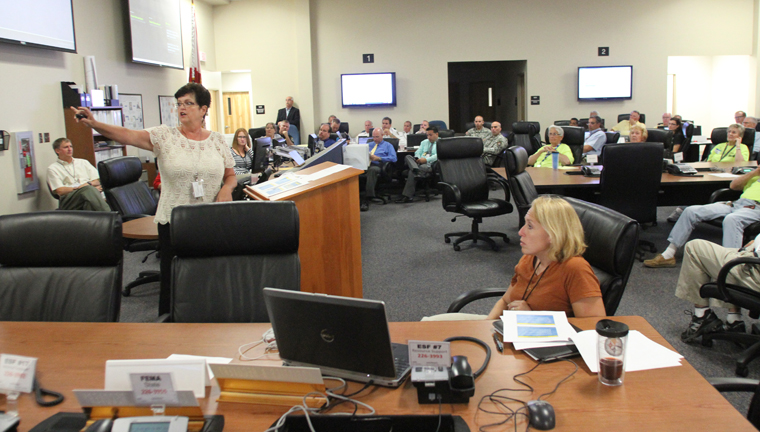INDIAN RIVER COUNTY — County officials and volunteers piled into the Emergency Operations Center in Vero Beach for a natural disaster response trial run on Wednesday morning.
Etta Jones, emergency management planner with the Indian River County Department of Emergency Services, explained the exercise that was expected to last more than two hours to the group comprised of city and county employees, and volunteers – approximately 70 people in total.
Dubbed “Hurricane Jones,” the practice-storm was a modified version of Tropical Storm Fay that ripped through a large portion of the state in 2008, and was the same simulated storm that all 67 counties in Florida responded to on Wednesday.
In case of an actual emergency or disaster, the EOC acts as the nucleus for all lead officials in the area.
“The decision makers are all sitting at these tables,” said Asst. Fire Chief Brian Burkeen.
The decision makers he spoke of were divided by category (human services, emergency services, infrastructure, and budget and finance), and sat around four separate conference tables in the command center’s hub.
Volunteers sat at call center stations in a room nearby, answering staged phone calls and transferring them to the appropriate “decision makers” just down the hall.
From the moment the simulation began, calls poured in. Each official worked in collaboration with one another to quickly and efficiently solve crises.
While representatives of the fire department worked with Florida Power and Light to restore power to portions of the city, Animal Control was advising a resident who complained of several snakes seeking high ground in his yard.
County school officials collaborated on when schools would open back up, while volunteers for the American Red Cross consulted on a multitude of issues involving shelters and mass food distribution.
Burkeen said the simulated scenario looks almost identical to a real life disaster situation, except for the more condensed time period.
“Ten years ago, we were here for 28 days. But then we didn’t have showers, didn’t have hot water, didn’t have any of those things,” Burkeen said.
He was referencing hurricanes Frances and Jeanne, which hit back-to-back, causing major damage to Indian River County and the surrounding area.
Since the 2004 hurricanes, the new EOC has been built, and is designed to withstand 200 mph winds, run on a generator for up to seven days, and only has three exterior windows on the entire structure.
In addition to the new building, new technology tools have been launched that will help with problem-solving efficiency.
Beginning this year, the Emergency Services Department is using a program called “VueTOO” that provides live updates to the command center on all things disaster-related including road closures, shelter openings, power outages, and even live Twitter and Facebook feeds.
Essentially, “VueTOO” has eliminated the need for “runners” – volunteers who would jet from the volunteer call center to each of the four official tables trying to collect and relay information from one person to another.
With “VueTOO” scrolling live on large television monitors in each room of the EOC, time is saved and decisions can happen faster.
Though Wednesday’s simulation was a practice run, volunteers and officials agreed that taking the trial run seriously was essential in working out the kinks and bugs in the system, including the new technology, in order to be fully prepared for a stellar response when the winds really begin to blow.
The Hurricane Season begins June 1.

